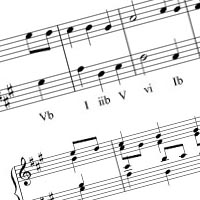This tutorial is going to walk you through how to harmonize a melody in 4 parts. The harmony we’re using is that of the classical common practice period.
Our Melody
To begin harmonizing this melody we must see which chords are available to us:
Step 1 – Add Cadences
The obvious cadences are in bars 1 to 2, 4 and 7 to 8.
- Bars 1-2 – The melody being leading note to tonic must be either an interrupted or inverted perfect cadence. Taking into account what follow an interrupted cadence would be best (V-VI).
- Bar 4 – This is the central cadence and the most obvious harmonisation is the use of a cadential sixth four (Ic-V).
- Bars 7-8 – This is the final cadence so it must be V-I in the tonic.
We now have the following incomplete sketch:
Step 2 – Add the Bass
Let’s take the opening. The D is a passing note so the chords would be Vb to I.
The B drops a 3rd to G sharp so the obvious choice of chord is IIb which follows nicely to the interrupted cadence.
The next chords can be harmonised by Ib-IV. In the melody there is a descending scalic passage and the C sharp is taken as an accented passing note so the harmony is:
The middle section is a sequential passage. First we must consider the key. The A sharp being a raised note is naturally the leading note of a new key, which would be B minor. The second part of the sequence is one note lower than the pattern, so therefore must be A major.
To establish B minor we must have some form of cadence and since this is not a central modulation, the cadence will have to be either interrupted or an inverted perfect. An inverted perfect is best as other solutions give problems. We’ll use V7d (dominant 7th in third inversion). The following notes in the melody B,C,D are the 1st, 2nd and 3rd degrees of the scale and the natural bass is D,C sharp and B (contrary motion is key here).
Continuing the sequence into A major we get:
The most difficult part of the working is done and we have the following complete sketch of the treble and bass:
Step 3 – Add The Inner Parts
When adding the inner parts, melodic and rhythmic interest can’t be ignored. It is best practice to keep the alto and tenor high rather than low as the tenor has a tendency to get tangled up with the bass.
Let’s look at completing the first two bars. They could be harmonized like this:
This is fine except for the overlap in the tenor and bass. We can fix this by using the following solution:
This result is more interesting and satisfactory than the previous example. Doubling the bass of IIb helps as it prevents the tenor from being too close to the bass.
To add more melodic interest we can add passing notes and we get:
Continuing the inner parts on the rest of the melody we end up with this:
At {a}, {b} an {c} note the doubling of the 3rd from the bass of the first inversion chord which in every case improves the melodic line of the tenor.
Summary
As you’ve seen harmonizing a melody can be divided into smaller tasks. It’s simply a matter of:
- Identifying cadences
- Adding the bass line
- Completing the inner parts
I hope you’ve enjoyed this article. I’ll be following this up with a modulating example in the future.


















